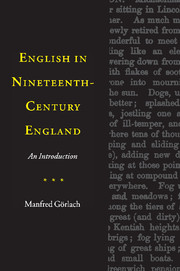Book contents
- Frontmatter
- Contents
- List of abbreviations
- Preface
- Acknowledgements
- List of figures
- List of texts
- 1 Introduction
- 2 Regional and social varieties
- 3 Spelling and pronunciation
- 4 Inflection
- 5 Syntax
- 6 Lexis
- 7 Text types and style
- 8 Provisional conclusions
- 9 Texts
- 10 Information on texts and authors
- References
- Index of names
- Index of topics and titles
- Index of selected words and pronunciations
3 - Spelling and pronunciation
Published online by Cambridge University Press: 17 May 2010
- Frontmatter
- Contents
- List of abbreviations
- Preface
- Acknowledgements
- List of figures
- List of texts
- 1 Introduction
- 2 Regional and social varieties
- 3 Spelling and pronunciation
- 4 Inflection
- 5 Syntax
- 6 Lexis
- 7 Text types and style
- 8 Provisional conclusions
- 9 Texts
- 10 Information on texts and authors
- References
- Index of names
- Index of topics and titles
- Index of selected words and pronunciations
Summary
Spelling
Take care of the sense, and the sounds will take care of themselves.
Spelling was the best-regulated part of the English linguistic system; at the turn of the century, an anonymous author could claim:
Though it cannot be denied, that there is still some difference in our orthography, owing to the affectation of writers and caprice of printers; yet it is observable, that, since the publication of Dr Johnson's Dictionary, and particularly the last edition, less variation is found; and … it is much for the credit of a language that its orthography should be fixed and immutable.
(Anon. 1797:i)However, certain options still remained even late in the 19th century (and many still remain, or are now classified as preferences of BrE as against AmE). James Murray (1888:x) notes variation in individual words like aerie (aery, eyrie, etc.) and ‘whole series of words’ ending in -able (blam(e)able), -eer/-ier, -ize/-ise ‘ and other endings, as to which current usage varies’. He adds:
In making [a] choice, regard is had chiefly to the preponderance of modern usage, when this is distinctly marked; when usage is more or less equally divided, considerations of etymological or phonetic propriety, of general analogy with similar words, or of practical convenience are taken into account; but, in many cases, it is not implied that the form actually chosen is intrinsically better than others which are appended to it.
(1888:x)- Type
- Chapter
- Information
- English in Nineteenth-Century EnglandAn Introduction, pp. 44 - 64Publisher: Cambridge University PressPrint publication year: 1999



